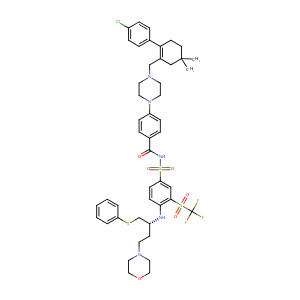| 1 |
ClinicalTrials.gov (NCT04041050) A Study Evaluating Safety and Tolerability, and Pharmacokinetics of Navitoclax Monotherapy and in Combination With Ruxolitinib in Participants With Myeloproliferative Neoplasm
|
| 2 |
Celecoxib FDA Label
|
| 3 |
URL: http://www.guidetopharmacology.org Nucleic Acids Res. 2015 Oct 12. pii: gkv1037. The IUPHAR/BPS Guide to PHARMACOLOGY in 2016: towards curated quantitative interactions between 1300 protein targets and 6000 ligands. (Ligand id: 2892).
|
| 4 |
ClinicalTrials.gov (NCT04472598) Study of Oral Navitoclax Tablet In Combination With Oral Ruxolitinib Tablet When Compared With Oral Ruxolitinib Tablet To Assess Change In Spleen Volume In Adult Participants With Myelofibrosis (TRANSFORM-1). U.S. National Institutes of Health.
|
| 5 |
URL: http://www.guidetopharmacology.org Nucleic Acids Res. 2015 Oct 12. pii: gkv1037. The IUPHAR/BPS Guide to PHARMACOLOGY in 2016: towards curated quantitative interactions between 1300 protein targets and 6000 ligands. (Ligand id: 8319).
|
| 6 |
Small molecules, big targets: drug discovery faces the protein-protein interaction challenge.Nat Rev Drug Discov. 2016 Aug;15(8):533-50.
|
| 7 |
Pfizer. Product Development Pipeline. March 31 2009.
|
| 8 |
Major role of human liver microsomal cytochrome P450 2C9 (CYP2C9) in the oxidative metabolism of celecoxib, a novel cyclooxygenase-II inhibitor. J Pharmacol Exp Ther. 2000 May;293(2):453-9.
|
| 9 |
Sulfonation of 17beta-estradiol and inhibition of sulfotransferase activity by polychlorobiphenylols and celecoxib in channel catfish, Ictalurus punctatus. Aquat Toxicol. 2007 Mar 10;81(3):286-92.
|
| 10 |
Celecoxib is a substrate of CYP2D6: impact on celecoxib metabolism in individuals with CYP2C9*3 variants. Drug Metab Pharmacokinet. 2018 Oct;33(5):219-227.
|
| 11 |
Cytochrome P450 2C8 pharmacogenetics: a review of clinical studies. Pharmacogenomics. 2009 Sep;10(9):1489-510.
|
| 12 |
Drug interactions in dentistry: the importance of knowing your CYPs. J Am Dent Assoc. 2004 Mar;135(3):298-311.
|
| 13 |
Clinical pipeline report, company report or official report of Roche (2009).
|
| 14 |
Clinical pipeline report, company report or official report of the Pharmaceutical Research and Manufacturers of America (PhRMA)
|
| 15 |
The B-cell lymphoma 2 (BCL2)-inhibitors, ABT-737 and ABT-263, are substrates for P-glycoprotein. Biochem Biophys Res Commun. 2011 May 6;408(2):344-9.
|
| 16 |
Effect of rifampin on the pharmacokinetics, safety and tolerability of navitoclax (ABT-263), a dual inhibitor of Bcl-2 and Bcl-XL , in patients with cancer. J Clin Pharm Ther. 2014 Dec;39(6):680-4.
|
| 17 |
Human breast cancer cells display different sensitivities to ABT-263 based on the level of survivin. Toxicol In Vitro. 2018 Feb;46:229-236. doi: 10.1016/j.tiv.2017.09.023. Epub 2017 Sep 23.
|
| 18 |
BCL2/BCL-X(L) inhibition induces apoptosis, disrupts cellular calcium homeostasis, and prevents platelet activation. Blood. 2011 Jun 30;117(26):7145-54. doi: 10.1182/blood-2011-03-344812. Epub 2011 May 11.
|
|
|
|
|
|
|


